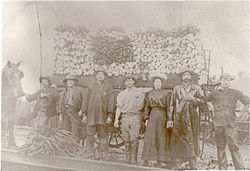History of Piccadilly Hall

1908-1935
A century ago the lush Piccadilly Valley was home to a thriving community of tiersmen (timber cutters), market gardeners, and orchardists. With its many natural springs and an annual rainfall almost double that of the Adelaide plains, the Valley served as an important source of fresh produce for Adelaide.
Construction of Piccadilly Hall was funded by a special levy established in 1907 by the Crafers District Council. Some doubt surrounds the exact date when the Hall was built, but a foundation stone on the eastern wall puts it at 1908. The Council met at the Hall until 1935.
Legislative changes to council boundaries 1929–31 led to the demise of the Crafers District Council, and ownership of the Hall passed back to the community in 1935, under the control of a local residents' committee.

1935-1954
Piccadilly's relative isolation made the Hall a community focal point. Regular Saturday night dances and other functions were a feature during and after the Second World War years (1939–45). In 1938 the front of the Hall was extended by 15 feet (5 metres), the porch added, and a piano purchased - all paid for through the community.
The decade of post-war years was a period of turmoil for the Hall and Piccadilly residents. The Stirling Council claimed ownership of the “Piccadilly Institute Hall” by proclamation on 25 February 1946. However, previous local council boundary changes placed the Hall within the East Torrens Council.
This arrangement only became clear to Piccadilly residents when the Stirling Council put the Hall up for sale by tender in 1953. After considerable debate and analysis of legal opinion, the Piccadilly community decided to purchase their Hall, and paid £1800 ($3600) to regain ownership.
And so, on 6 May, 1954, the Hall was purchased as a community asset, to be managed and maintained by a residents’ volunteer committee as a not-for-profit incorporated entity.


1954 - today
During the 1970s, Saturday dances adopted a different form with the Hall being used for a Disco for local teenagers. A Federal Government grant in 1978 enabled a major upgrade of the Hall, with addition of a new roof, kitchen and toilet facilities.
At the height of summer on 16 February, 1983, a bushfire raged through the Adelaide Hills causing substantial destruction and death, and the Hall became a refuge for those locals who had lost houses in the inferno that became known as Ash Wednesday. For the rest of 1983, The Hut (a Stirling community group) used the Hall as a clothing and furniture outlet for locals whose possessions had been destroyed in the fire. The Hall also functioned as an “Op Shop” 1984-96, operated by the Piccadilly volunteer Country Fire Service (CFS).
In 1994 the Hall was registered as a Council-listed Heritage Site. It was repainted in 1996, cracks repaired, front, side and rear doors replaced, and a new jarrah floor fitted.
Inside the Hall a memorial commemorates Hills lads who fought in The Great War (1914-18). Many of their names such as Bonython, Curtis, Gore, Lampert, Schocroft, Sprigg, and Udy are now familiar as road names within the Piccadilly district.
The Piccadilly Hall is a community asset. It is a significant part of our local heritage, run and maintained for the community, by the community. Revenues from hire of the Hall are an essential source of funding towards its upkeep. Maintenance and upgrading of the Hall continue as donations and funds raised through community use permit.
The Committee acknowledges the assistance of Glendon Rogers in compiling this history of the Hall,
and his 40 years of dedicated service in managing the Hall.
Gallery
 Piccadilly Community |  Lampert Wagon loaded for market - 1905 R-L: Will Lampert, Harry Lampert, Stan Mosel, Syd Lampert, Janet (Lampert) Mosel, Fred Mosel, Charlie Lampert |
|---|---|
 Janet Lampert - nee Lewis 1844-1925 |  Frederick William Leopald Lampert 1839-1926 |
 Elisabeth and Richard Sandercock early 1920's |  Elisabeth Sandercock late 1920's |
 The Old Post Office 1940's |  The Old Post Office 1920's |
 The Old Post Office 1960's |  The Old Post Office from rear 1960's |
 The Old Post Office from rear 1960's |  Piccadilly from Carminow coloured postcard early 1900's |
 Piccadilly from Carminow early 1900's |  Piccadilly from Carminow early 1900's |
 Piccadilly from Carminow early 1900's |  Piccadilly from Carminow early 1900's |
 Piccadilly from Carminow early 1900's |  Rear view from the Old Post Office 1960's |